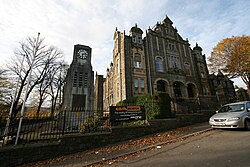Blaenavon
| Blaenavon | |
| Monmouthshire | |
|---|---|
 Blaenavon Workingmen's Institute | |
| Location | |
| Grid reference: | SO225095 |
| Location: | 51°46’12"N, 3°4’48"W |
| Data | |
| Population: | 6,349 |
| Post town: | Pontypool |
| Postcode: | NP4 |
| Dialling code: | 01495 |
| Local Government | |
| Council: | Torfaen |
| Parliamentary constituency: |
Torfaen |
Blaenavon is a town and World Heritage Site in Monmouthshire. The town stands high on a hillside and has a population of 6,349 people.
This was once a place of heavy industry - coal and iron - and the tonw grew up around those industries. The mines and the works have now closed but their importance has been recognised: the Blaenavon Industrial Landscape is now enrolled as a World Heritage Site.
History
Blaenavon grew around an ironworks[1] opened in 1788, part of which is now a museum. The steel-making and coal mining industries followed, boosting the town's population to over 20,000 at one time,[2] but since the ironworks closed in 1900 and the coal mine in 1980, the population has declined, and now consists mostly of older citizens.
Attractions in the town include the Big Pit National Coal Museum (an Anchor Point of the 'European Route of Industrial Heritage'), Blaenavon Ironworks,[3] the Pontypool and Blaenavon Railway, the sights of the Blaenavon World Heritage Centre, Blaenavon Male Voice Choir and many historical walks through Blaenavon's mountains.
Blaenavon is town twinned with Coutras in France.
Time Team dig
The Channel 4 archaeology television programme Time Team came to Blaenavon during its February 2001 series to find "The Lost Viaduct" - "the world's first railway viaduct". This had been built in 1790, to be used by horse-drawn wagons to carry coal from the mines. Despite being about 130 feet long and 30 feet high, within about 25 years of its construction it had completely disappeared. But with no records of its demolition, the group was there to see what might remain of this structure. Eventually, during the mid to late afternoon of the final (third) day of the excavation, the team managed to uncover the top of the viaduct, the arched roof of which, under 40–50 feet of rubble and earth, was seemingly still standing. However, because it was so late on their last day, and for reasons of safety, they were unable to dig any further.
-
Big Pit Mining Museum
-
Rail manufactured in Blaenavon, seen in Sweden
-
Book town Blaenavon


